Difference between revisions of "VTube STAR SVNet Bender Communications"
| Line 6: | Line 6: | ||
<tr valign=top> | <tr valign=top> | ||
<td width=300> | <td width=300> | ||
| − | This page describes the use of the VTube-LASER to STAR bender new data setup and corrections using the STAR SVNet protocol.<br><br> | + | This page describes the use of the VTube-STEP and VTube-LASER to STAR bender new data setup and corrections using the STAR SVNet protocol.<br><br> |
<br><br> | <br><br> | ||
| Line 23: | Line 23: | ||
<td width=300> | <td width=300> | ||
The protocol used is called "STAR SVNet" and runs through a standard network connection - wired or wireless.<br><br> | The protocol used is called "STAR SVNet" and runs through a standard network connection - wired or wireless.<br><br> | ||
| − | [[VTube-LASER]] | + | [[VTube-STEP]] and [[VTube-LASER]] use a modified Supravision Network protocol to send new part data and bender part corrections to STAR EVO benders.<br><br> |
</td> | </td> | ||
| Line 32: | Line 32: | ||
</table> | </table> | ||
| − | = | + | =STAR SVNet Data Protocol Information= |
These are important facts to know about this protocol. | These are important facts to know about this protocol. | ||
| Line 38: | Line 38: | ||
<tr valign=top> | <tr valign=top> | ||
<td width=500> | <td width=500> | ||
| − | * The | + | * The STAR SVNet protocol is network protocol. It can be setup over a network or for use with a thumb drive.<br><br> |
| − | * The | + | * The protocol can be used to send NEW part data or CORRECTED data to the bender.<br><br> |
| − | * | + | * Unlike the standard SVNet protocol, the STAR SVNet protocol is unidirectional. Data only flows from VTube to the STAR.<br><br> |
| − | * Th reason it is unidirectional is because the | + | * Th reason it is unidirectional is because the STAR control is not designed to respond to VTube-LASER RECALLS during bender correction.<br><br> |
| − | * Therefore, the RECALL button in the VTube-LASER Bender Setup window is always disabled with the | + | * Therefore, the RECALL button in the VTube-LASER Bender Setup window is always disabled with the STAR SVNet protocol.<br><br> |
| − | * The | + | * The STAR SVNet protocol requires that the operator ensure that the pre-correction data in the blue columns matches the current STAR bender data before corrections are sent (Orange columns) to the bender. VTube-LASER will warn the operator of this in a simple dialog before the SEND is completed. |
Revision as of 13:20, 23 July 2018
|
This page describes the use of the VTube-STEP and VTube-LASER to STAR bender new data setup and corrections using the STAR SVNet protocol. |
Back to VTube-LASER
Network Protocol
|
The protocol used is called "STAR SVNet" and runs through a standard network connection - wired or wireless. |
STAR SVNet Data Protocol Information
These are important facts to know about this protocol.
|
BENDERLINK SETUP STEPS FOR VTUBE-LASER
STEP 1: Enter the SYSTEM OPTIONS Menu in VTube
|
STEP 2: Setup the Benderlink Network Grid for HERBER MES Protocol
|
 How to SEND CORRECTION Data to the HERBER Control from VTube-LASER
How to SEND CORRECTION Data to the HERBER Control from VTube-LASER
STEP 1 - Bend the Tube
|
Bend the tube in the HERBER bender. |
STEP 2 - Measure the tube with VTube-LASER
|
Measure and align the tube to determine if it qualifies by falling within the envelope tolerance for the tube shape. |
STEP 3 - Enter BENDER SETUP
|
Click on the BENDER SETUP button in the Navigation Pane. |
STEP 4 - Choose the BENDER NUMBER
|
Set the correct bender number at the top of the window. |
STEP 5 - COPY the Data from VTube-LASER's Main Memory
|
If this is the first correction, then the Bender Setup screen may show no data. If this is the case, then it is necessary to update the Bender Setup screen from VTube-LASER's main memory like this:
|
STEP 6 - OPTIONAL STEP - You Can Manually Change the ADJUSTMENT Values
|
You can manually change the ADJUSTMENT values before sending corrections if you want to. Some users like to set the first and last Length adjustment to zero in order to keep the start position of the carriage in the same place - for when they have extra length on the ends. |
STEP 7 - Send Corrections to the HERBER
|
Press "Auto SEND Bender CORRECTIONS". VTube-LASER will let you select a path, then save a MES file to that path. |
STEP 8 - The SEND to BENDER Complete Window
|
A window should appear for a few seconds indicating that the Send to the Bender is complete. |
STEP 9 - IMPORT the Correction Data at the HERBER Control
|
Move to the HERBER control and follow these steps:
|
|
|
|
|
STEP 10 - REPEAT STEPS 1 THROUGH 9
|
Bend the corrected tube starting in Step 1, then measure it again (Step 2) and follow the rest of the steps until the part is within tolerance. |
Other Pages
- See VTube-LASER
- See VTube-STEP
- See UNISON for information on UNISON benders


















